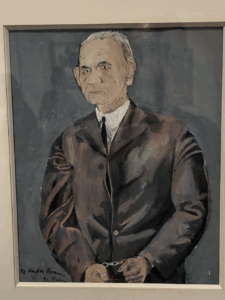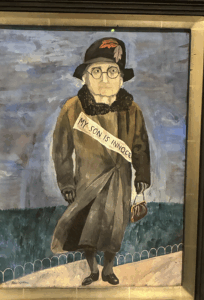
 Good Morning and greetings from Greenpoint
Good Morning and greetings from Greenpoint
You would not figure that a visit to New York’s Jewish Museum would uncover the forgotten story an Irish American cause celebre of the 1920s and 1930s, but it did. I discovered there the amazing, but now forgotten, story of labor activist Tom Mooney while visiting the retrospective of Jewish American painter Ben Shahn. I would highly recommend catching the retrospective: Ben Shahn, On Non-Conformity that runs at the Jewish Museum through October 26th.
Before I get to the Mooney story, lets discuss painter Ben Shahn. Though largely forgotten today, Shahn achieved a worldwide fame for his many canvases that highlighted American injustice. Shahn was drawn to the theme of injustice because he and his family had suffered injustice in Europe and here in New York. Shahn was born into a Jewish family in 1898 in Lithuania. His father was arrested by the Czarist authorities and exiled far away from the family to Siberia on suspicion of being a revolutionary. Ben and his mother fled Lithuania and settled in Williamsburg, Brooklyn where they were later joined by Ben’s father. The family suffered poverty, and even though Ben was an excellent student, his family’s inability to pay for higher education meant that Ben could not study in college full-time. Shahn apprenticed as a lithographer but also developed his talent as a painter by studying art at night at City College and the National Academy of Design. A leftist, burning with indignation at the wrongs he perceived in the world, Shahn decided to paint in a realist style highlighting court cases that were travesties of injustice. Outraged by the 1927 conviction and execution of Italian anarchists Sacco and Vanzetti in Massachusetts, Shahn depicted the trial of the Italians in a 1932 series of paintings entitled The Passion of Sacco and Vanzetti, which established his worldwide reputation as a talented painter determined to depict injustice.
Soon after, Shahn, decided to paint another series of canvases highlighting the bogus conviction of Mooney on murder charges. Tom Mooney was born in Chicago to poor Irish parents in1882. His father was a coal miner and union activist who died of tuberculosis at the age of 36. At age fourteen, Mooney was forced to work at a local factory, where he apprenticed as a molder and joined the Molders Union. When he saved enough money, Mooney visited Ireland and the continent where he was exposed to the ideas of socialism. Before he headed home, Mooney had become an ardent socialist who decided to dedicate his life to the struggles of the working class. In 1916, Mooney, a militant anti-war activist, was living in San Francisco. The US was moving closer towards entering World War I and San Francisco hosted a huge, jingoistic “Preparedness Day Parade”, featuring tens of thousands of marchers. Half an hour into the parade at 1:50 PM, a bomb exploded, killing ten and injuring 40. A century later, the true perpetrators remain unidentified, but in the ensuing hysteria and rush for scapegoats, Mooney and his friend Warren K Billings became suspects. Rewards for information, totaling $17,000 produced what The New York Times called a “sweepstakes of perjury.” Mooney and Billings were put on trial, even though none of the witnesses of the bombing identified the defendants in the lineup. Two men came forward and testified that they had seen Billings and Mooney plant the bomb. The defense presented an ironclad alibi, a photograph showing Mooney and his wife standing under a clock a mile away from the scene at the time blast, but the two anti-war activists were still convicted of the crime. Billings received life in prison while Mooney was sentenced to be executed. The judge in the case admitted in a letter that the case had been “one of the dirtiest jobs ever put over.” Among those doubting Mooney’s guilt was President Woodrow Wilson, who lobbied the governor of California in vain for a pardon, but because it was a state crime Wilson was powerless to intervene.
Mooney became an internationally recognized martyr. His death sentence was commuted but Republican governors of California refused to pardon him, and he languished in prison for years. By the 1930s, Mooney had become one of the world’s most famous Americans. One survey put him in the top four, with Franklin D Roosevelt, Henry Ford, and Charles Lindbergh. Writers around the world, including Ireland’s George Bernard Shaw clamored for his release to no avail. The frame-up would create another international celebrity, Mooney’s Bellmullet, Co. Mayo-born mother Mary Heffernan. Shahn depicts her in one of the canvases in the series wearing a sash reading, “My Son is innocent.” Though in her late sixties and in poor health, Heffernan through herself headlong into her son’s defense, traveling across the country speaking to large, boisterous crowds advocating her son’s release. She soon gained international fame as “Mother Mooney.” Portrayed around the world as the militant mother of an unjustly convicted son, Heffernan embraced the causes of other people wrongly incarcerated. She became a symbol of a broad campaign for political prisoners and was even invited to speak at meetings in European capitals such as London, Berlin and Moscow, where she demanded not only the immediate release of her son from prison, but also justice for a group of wrongly convicted African American teenagers facing execution on Alabama’s death row. Her son was incarcerated in San Quentin Penitentiary where a host of celebrities came to visit him, including leading Irish activists like trade-unionist Jim Larkin, and feminist Hanna Sheehy Skeffington. In 1932, the Los Angeles Olympics became the scene of agitation for Mooney’s release when protestors wearing “Free Mooney” placards invaded the running track at the Lost Angeles Coliseum. It would take seven more years, but the global campaign helped bring about the eventual exoneration of both Mooney and the Scottsboro boys. Mooney was finally released from prison in 1939 after serving twenty-two years, but he was an old man by then who had only three more years to live. Shahn’s striking canvases resurrect an era where there was a burning passion to fight injustice and stand in solidarity with its victims. It seems a far cry from today’s widespread indifference to the many injustices of our world today.
.
